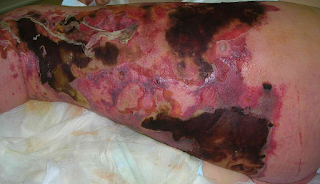 |
| Image Credit: Wikipedia |
 |
| This post was peer reviewed. Click to learn more. |
Author: Lauren Van Woy, OMS III
Western University of Health Sciences, College of Osteopathic Medicine of the Pacific
Introduction
Necrotizing fasciitis is a rare but potentially fatal dermatologic infection that emergency physicians must be able to promptly recognize and treat. Misdiagnosis of necrotizing fasciitis is common, with 41% to 96% of cases falsely identified as a less serious soft tissue infection (such as cellulitis or an abscess).[1] Failure to treat necrotizing fasciitis can lead to sepsis, organ failure, and death.[2] Therefore, it is imperative to have a low threshold for diagnosis.
Epidemiology
There is an estimated incidence of 1000 cases of necrotizing fasciitis annually in the United States.[3] There is no gender or age preference.[3] Several co-morbidities are associated with necrotizing fasciitis, with diabetes mellitus being the most common.[1] Other risk factors include severe peripheral vascular disease, trauma, alcohol, and intravenous drug use, non-steroidal anti-inflammatory drug (NSAID) use, and recent surgery.[4] Necrotizing fasciitis has a 25% to 35% mortality rate overall, and liver cirrhosis is positively correlated with a poor outcome.[1]
Etiology
Necrotizing fasciitis is a deep bacterial skin infection that travels quickly along fascial planes. In 80% of the cases, it occurs as an extension of an infection at the site of minor trauma, such as an abrasion, insect bite, or furuncle.[3]
There are three main types of necrotizing fasciitis. Type I infections are polymicrobial and are associated with recent surgery or trauma.[4] Common causes include Streptococcus (non-group A), Bacteroides, Peptostreptococcus, and Enterobacteriaceae.[4] Type II infections are caused by a single organism. Common pathogens include group A beta-hemolytic Streptococcus, Staphylococcus aureus, Enterobacteriaceae, and the Bacteroides species.[3] Type III infections are caused by gram negative marine organisms, generally Vibrio vulnificus.[3] When necrotizing fasciitis is localized to the perineum or genitals, it is known as Fournier gangrene.[4]
Diagnosis
Clinical Presentation
The diagnosis of necrotizing fasciitis is made clinically.[3] The most common symptoms include swelling, pain, and erythema, in a patient who appears severely ill.[1] As the infection advances, the patient may present with skin necrosis, bullae, and crepitus.[1] Septic shock and hypotension are late findings and are strongly associated with mortality.[1]
The most consistent feature of necrotizing fasciitis is pain out of proportion to the swelling and erythema.[1] Other symptoms that may help distinguish necrotizing fasciitis from less aggressive skin infections include tenderness extending beyond the apparent involved area, indistinct margins, and rapid progression (typically over hours) despite the use of antibiotics.[1] The subcutaneous tissues often have a hard, wooden feel.[3]
To confirm suspected necrotizing fasciitis, a physician may create a small exploratory incision at the site of suspicion.[3] The tissues are easily dissectible with a blunt instrument or gloved finger, and there is often a watery, brownish, foul-smelling fluid (described as “dishwater” fluid) in the region.[1] The fascia appears grey and swollen.[3]
Laboratory Testing and Imaging
Common laboratory findings include a white blood cell count greater than 14,000 cells/mm3, blood urea nitrogen level greater than 15mg/dL, and a serum sodium level less than 135mEq/L.[4]
Computed tomography or magnetic resonance imaging may demonstrate edema along the fascial planes, and plain films may show subcutaneous emphysema.[3] However, it is important to remember that treatment of the disease should not be delayed to obtain radiologic studies.
Treatment
Once an emergency physician recognizes necrotizing fasciitis, immediate antibiotic therapy, fluid resuscitation, and wide surgical debridement are warranted.[2,5] In addition to a general surgery consult, commonly involved specialties include critical care, infectious disease, and plastic surgery.[3] It is the responsibility of the emergency physician to advocate on behalf of the patient, knowing the critical nature of the underlying disease process.[2]
Although no studies prove causation, there is a suspected association between NSAID use and the development of necrotizing fasciitis, possibly due to an altered immune response.[3] Further studies are needed on this topic, but for now, NSAIDS should be avoided in patients with suspected necrotizing fasciitis.[3] Pain control should instead be managed by narcotics such as morphine and oxycodone.[3]
Initial intravenous antibiotic therapy recommendations include: [5]
- Polymicrobial
- Piperacillin-tazobactam PLUS vancomycin or
- Imipenem-cilastatin or
- Meropenem or
- Ertapenem or
- Cefotaxime PLUS metronidazole or clindamycin.
- Streptococcal
- Penicillin PLUS clindamycin.
- Staphylococcus aureus
- Nafcillin or oxacillin or
- Cefazolin or
- Vancomycin (for resistant strains) or
- Clindamycin
Following surgical debridement, patients should be admitted to the intensive care unit for fluid, electrolyte, nutrition, and temperature management.[3]
Conclusion
Necrotizing fasciitis is a rapidly progressive soft tissue infection, and a true dermatologic emergency. Due to the precipitous nature of the disease, early diagnosis and treatment are critical. It is crucial for emergency physicians to become familiar with the signs and symptoms of necrotizing fasciitis and maintain a low threshold for diagnosis of the disease. Treatment of necrotizing fasciitis includes immediate admission, antibiotic therapy, and wide surgical debridement. The emergency physician must coordinate well with other members of the patient care team to provide prompt and optimal care.
References:
- Goh T, Goh LG, Ang CH, Wong CH. Early diagnosis of necrotizing fasciitis. Br J Surg. 2014;101(1):e119-25.
- Galust H, Oliverio MH, Giorgio DJ, Espinal AM, Ahmed R. Necrotizing Fasciitis: An Emergency Medicine Simulation Scenario. Cureus. 2016;8(8):e758.
- Hakkarainen TW, Kopari NM, Pham TN, Evans HL. Necrotizing soft tissue infections: review and current concepts in treatment, systems of care, and outcomes. Current Problems in Surgery. 2014;51(8):344-62.
- Usatine RP, Sandy N. Dermatologic Emergencies. American Family Physician. 2010; 82(7):773-80.
- Stevens DL, Bisno AL, Chambers HF, et al. Practice guidelines for the diagnosis and management of skin and soft tissue infections: 2014 update by the infectious diseases society of America. Clinical Infectious Diseases. 2014;59(2):147-59.
